Indonesia – what a vast country, consisting of 17,508 islands. And let us tell you something? We had only explored two of them up to this point: Bali and Nusa Lembongan. So, there were still a lot of islands waiting for us.
We wanted to see more and set off from Bali to Java. Air Asia was a bit delayed, so we didn’t land in Jakarta until 1.5 hours later. We had 14 exciting days ahead of us; we could hardly wait to finally begin our train journey through Java.
- Journey to the Thousand Islands
- The largest city in Southeast Asia – Jakarta
- Through the oldest Chinatown in Indonesia
- Train journey through Java – on to Bandung
- Off to Taman Wisata Maribuya Park
- The cool Lawangwangi Creative Space
- A train ride on to Yogyakarta
- Traveling with a local
- The unique Borobodur Temple
- The impressive Prambaran Temple
- Our accommodations at a glance
- Train tickets for Java
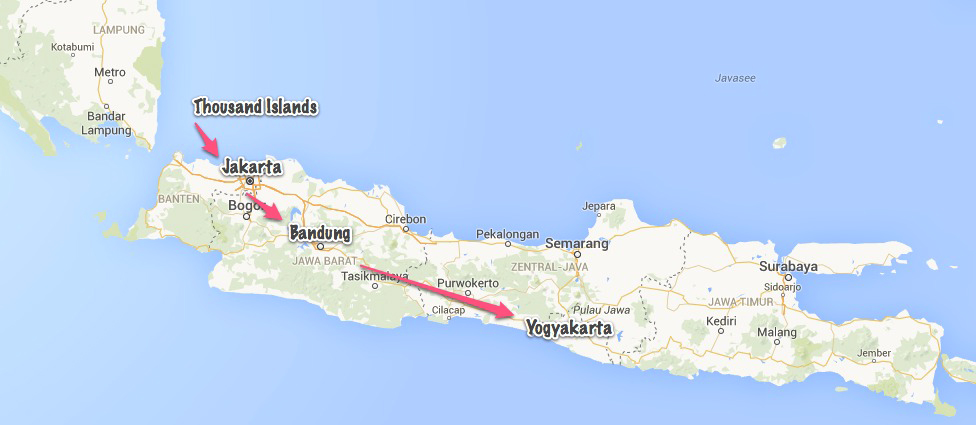
Trip to the Thousand Islands
Jakarta was initially just supposed to be our starting point for a trip to the Thousand Islands. We actually hadn’t even considered that there would be any “beautiful islands” near Jakarta. We became aware of them through a video by Backpacking Simon.
So we researched online and tried to make a plan. It wasn’t easy, as there wasn’t much information available online. But it was also a good sign, because apparently tourism hadn’t arrived here yet. In the end, we were able to find accommodation and also received the necessary information for our arrival.
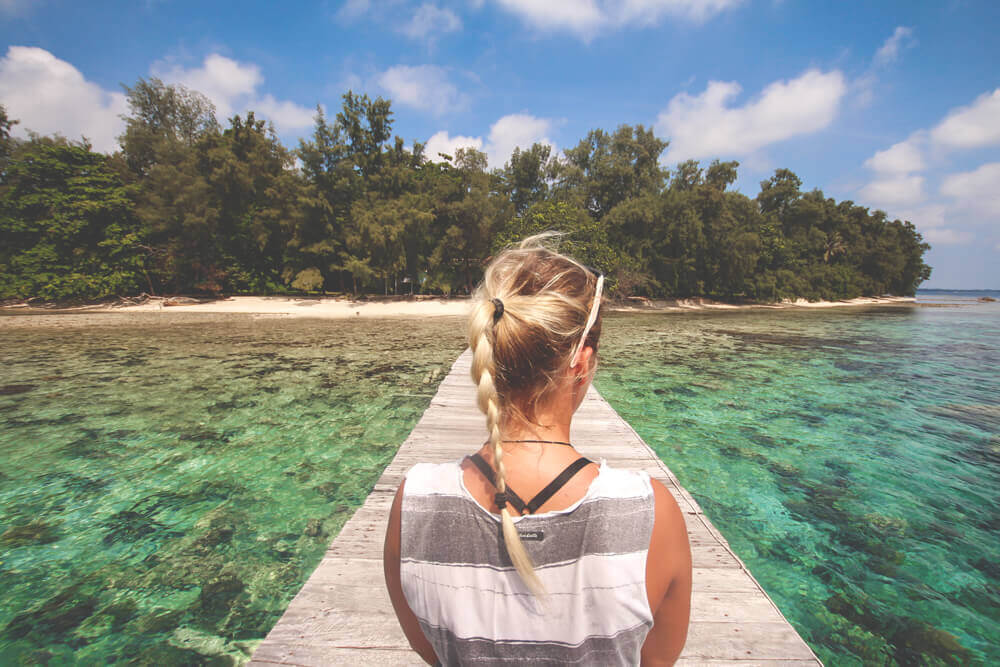
So we only stayed one night in Jakarta and drove to the Marina Anchol harbor the next morning. From there, we took a speedboat (just under 9 euros) to Pramuka Island, the administrative island of the archipelago (all information about this will be available in a separate article soon). More than 130 islands lie off the coast and the port of Jakarta – some can be reached in 20 minutes, others in 3 hours.
Not all of them are inhabited, but most people live on Pramuka Island or Pulau Kelapa. Pramuka is very small, and it only takes about 10 minutes to walk from west to east. Simple houses and huts are everywhere. You’ll find only a few small local shops and a few food stalls, as well as a soccer field, a mosque, a turtle breeding center, and a marketplace – that’s it! The island was a perfect base for exploring other islands.

So we went snorkeling for two days with local guys. The water there was crystal-clear, and the many beautiful corals were bright and colorful. We saw many sea urchins, starfish, and a variety of fish species. It was incredibly beautiful out there. We didn’t see a single tourist, and that’s not something you see very often.
Plus, we were alone, and it was simply stunning! The area is extremely local and simple, yet the people were very friendly to us, albeit mostly very shy and reserved. Some people looked at us as if we came from another planet. Some of it was really funny.

The largest city in Southeast Asia – Jakarta
We stayed on Pramuka Island for three nights and then made our way back to Jakarta. We were somehow afraid of this city. When we thought of Jakarta, the only words that came to mind were: dirt, stench, noise, traffic chaos, heat! And that’s exactly what it was like. After about an hour and a half, we reached the harbor again and took a taxi to our hostel. We booked the Teduh Hostel in the north of the city for the next three nights.
Since we only really had time on the two mornings of Saturday and Sunday due to work, we set off for the “Monumen Nasional” on the first day. It was actually only a 5-kilometer taxi ride, but it took us more than 30 minutes to get there. The streets were, as always, pretty congested. Everyone was honking their way out of the chaos, no one could or wanted to make way.
Everyone was pushing their way out of the chaos, bit by bit. You get used to it quickly, but it’s still annoying. Whether on foot, by bus, taxi, tuk-tuk, or train – it always takes an extremely long time to get from A to B. Oh, and Jakarta isn’t exactly small. With almost 30 million inhabitants in the entire region, Jakarta is the second-largest metropolitan area in the world and the largest city in Southeast Asia. We thought Bangkok was big, but you have to experience Jakarta first!
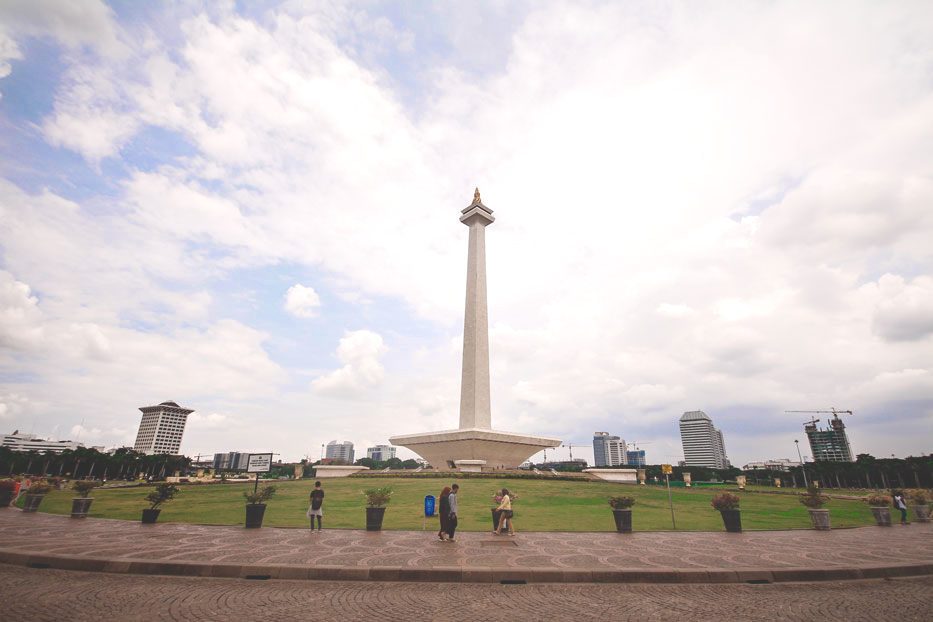
Back to the monument. This 137-meter-high tower was opened in 1975 and symbolizes Indonesia’s struggle for independence. At the very top, you’ll find a flame covered in 35 kilograms of gold. You can even look down on the city from above. Unfortunately, all tickets were sold out that day, so we couldn’t catch a glimpse of Jakarta. This observation deck is 115 meters high. (Entrance fee: 1-2 euros).
We strolled a bit through the large park (probably one of the quietest places in the city) and then decided to visit a mosque, as it was very close. The Istiqlal Mosque (Masjid Istiqlal) was built in 1975 and is the largest mosque in Southeast Asia. It can accommodate more than 120,000 worshipers. We had to wear some kind of robe/cloak because our clothes were too short. So we strolled through the aisles of this enormous mosque.
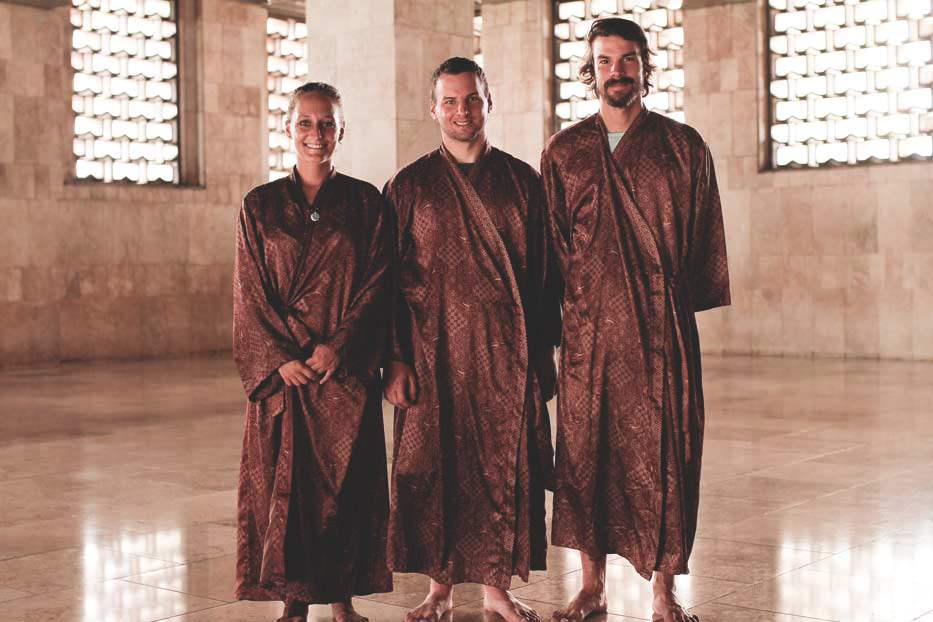
In the middle, a few worshipers gathered for prayer. If you imagine what this mosque must look like when 120,000 people gather there… what a sight (just google the mosque and you’ll see pictures with thousands of people). It was somehow a strange feeling being there – as a non-believer. But the glimpse into this building was impressive.
Through the oldest Chinatown in Indonesia
The next morning we arranged to go on a tour. I found information about various walking tours online. The tour operator “Jakarta Good Guide” offers six different tours. We really wanted to experience Chinatown, as it was supposed to be the oldest Chinatown in Indonesia. Besides, a Chinatown is always so beautifully diverse, colorful, and lively. The tour operates according to the principle: “Pay what you want at the end!” Dates and tours can be found on the homepage.
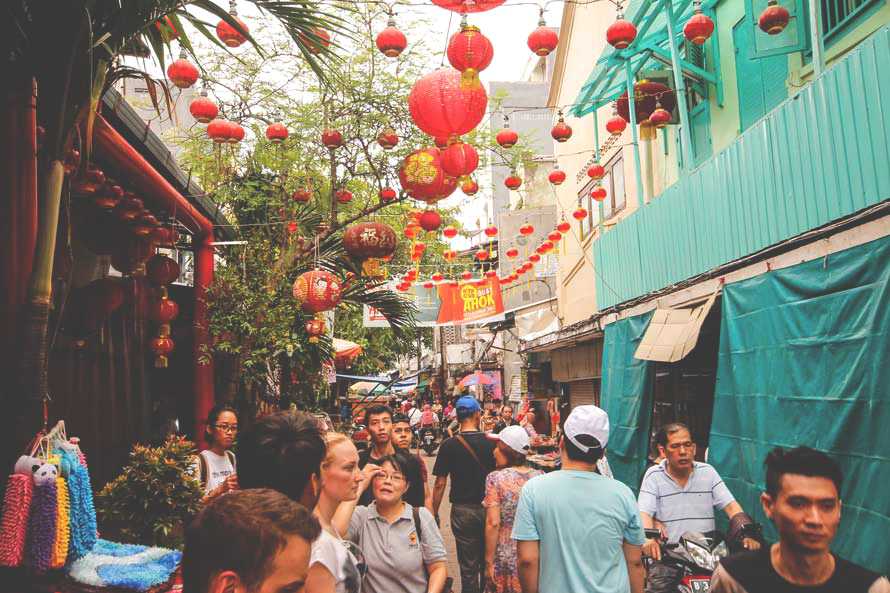
The meeting point was at 9:00 a.m. at the Novotel in the north of the city, just 15 minutes from our hostel. Rita, a Chinese woman (I think), was already waiting for us there. She didn’t speak English very well, so we only understood half of it. But it was still pretty cool because she led us through the streets, and we could finally leave Google Maps and city maps in our backpacks.
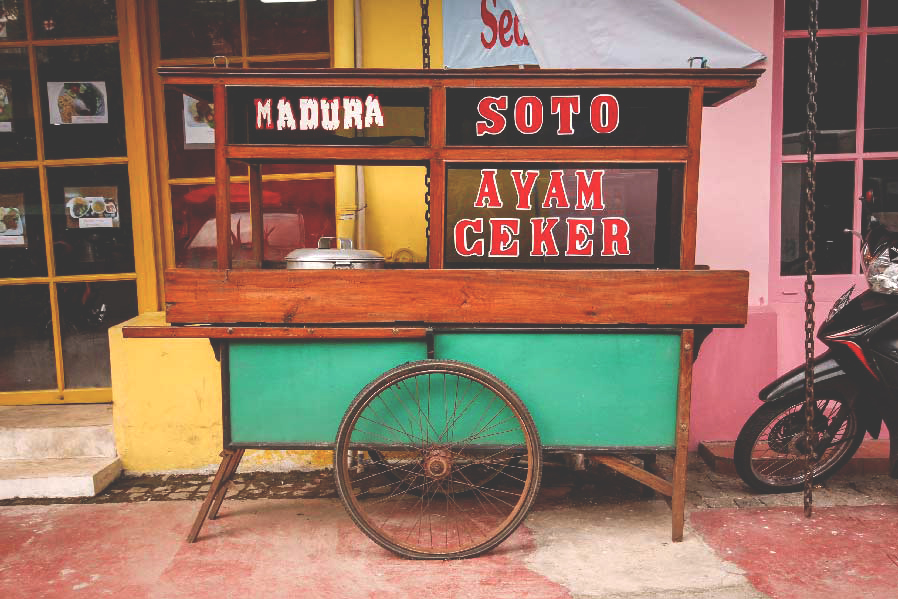
We saw many temples and, above all, a bustling alley with an enormous amount of food: fruit, vegetables, fish, meat, and other animals, like frogs. It was strange to see a skinned frog on a grill. We didn’t want to try it—it wasn’t our cup of tea. ^^
Train Journey to Java – Onward to Bandung
We actually knew nothing about Bandung. What we did know, however, was that the surrounding area was supposed to be beautiful, with waterfalls, volcanoes, and strawberry farms. We bought a train ticket for “Bisnis” class. This sounds better than it is, but it was still quite comfortable. The ticket cost us just under 6 euros, and the journey took about 3.5 hours.
The train slowly moved through the streets of Jakarta, and we got closer and closer to the “exit.” It became quieter, and the view opened up more and more. Soon, there were no more high-rise buildings, streets, traffic, or people to be seen. Now we had arrived in the beautiful landscapes. One rice field after another, and everything was lush green. We drove over high bridges with views into deep gorges.
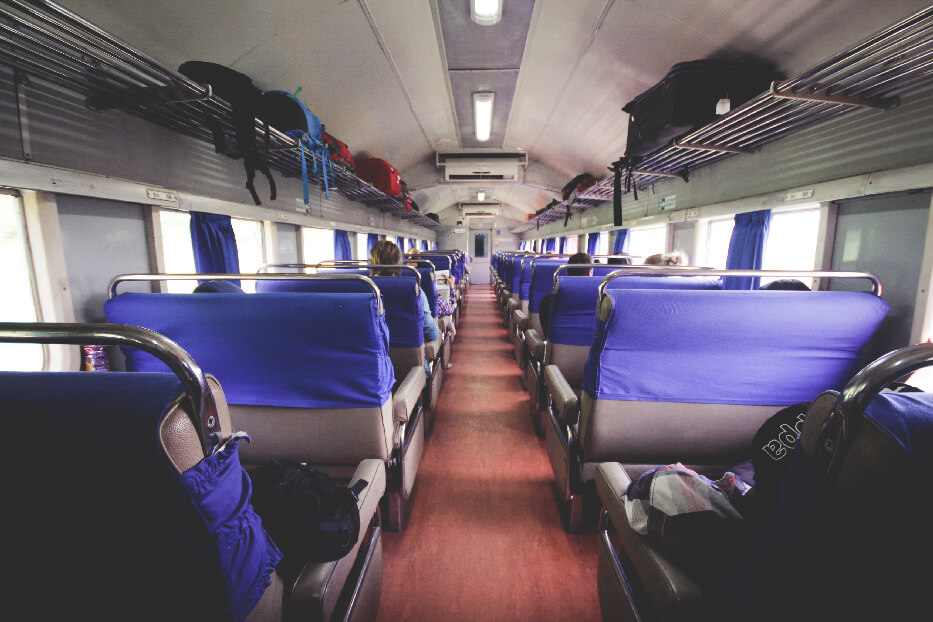
The train chugged along; we certainly weren’t traveling fast. The journey was quiet and relaxing. I repeatedly darted to the door with my camera to take a few photos. Suddenly it got dark and started to rain. 30 minutes later, the thick clouds cleared again and the sun came out. Only a few meters to Bandung.
What? There are no more train or bus tickets?
When we arrived in Bandung, we wanted to order train tickets for our onward journey directly at the train station. We went to the counter, filled out our “order form” again, and waited. Finally, it was our turn. But then the disappointment. It was Monday, and we wanted to continue on to Yogyakarta on Wednesday. Unfortunately, Thursday was a holiday (like in Germany), and so all bus and train tickets were sold out by Thursday evening.
Nothing else worked. The earliest ticket wasn’t available until Friday morning. It was also the most expensive, but we had no other option. We had to reach Yogyakarta before the weekend, as I had to work Saturday and Sunday as usual. So we bought these super expensive tickets for almost 25 euros (extra class). At least they were tickets for the best class.
The worst hostel we’ve ever stayed in!
From the train station in Bandung, we walked down the street for about 20 minutes until we reached the hostel. We had booked it at short notice from Jakarta. It was well-rated and not expensive – perfect, in other words. When we arrived, they wanted to put us in an 8-person room. But we had booked a 4-person room. We argued for a few minutes and finally got our 4-person room. It was a “women’s room,” and we moved in with two men (Marco and a friend) = living life on the edge.
When we entered the room, we could hardly believe our eyes. It was really dirty and musty – no matter where you looked. The beds were falling apart, and it was extremely loud. The fan was growing mold, and a small towel lying under the sink was already starting to grow dead.

The planes flew directly over the hostel—what a scene. We couldn’t understand all the good reviews—it’s definitely not recommended. The hostel crew was always smoking downstairs, so the smoke drifted up into all the rooms. Not pleasant for non-smokers, but also for smokers. They didn’t speak English well, so communication was quite difficult. But that wasn’t so bad – after all, the internet was very good and we could do some research online.
City Tour of Bandung
After the initial shock, we immediately booked the Garden Hostel for the next two nights and were able to start planning the next few days. After all, we now had almost four full days instead of the planned two. On the first day, we walked through the streets to get an overview. The city has little “flair and charm” – more like a typical Java City. Quite gray, quite loud, and a bit dirty. Only one street in the center was quite cool, somehow.
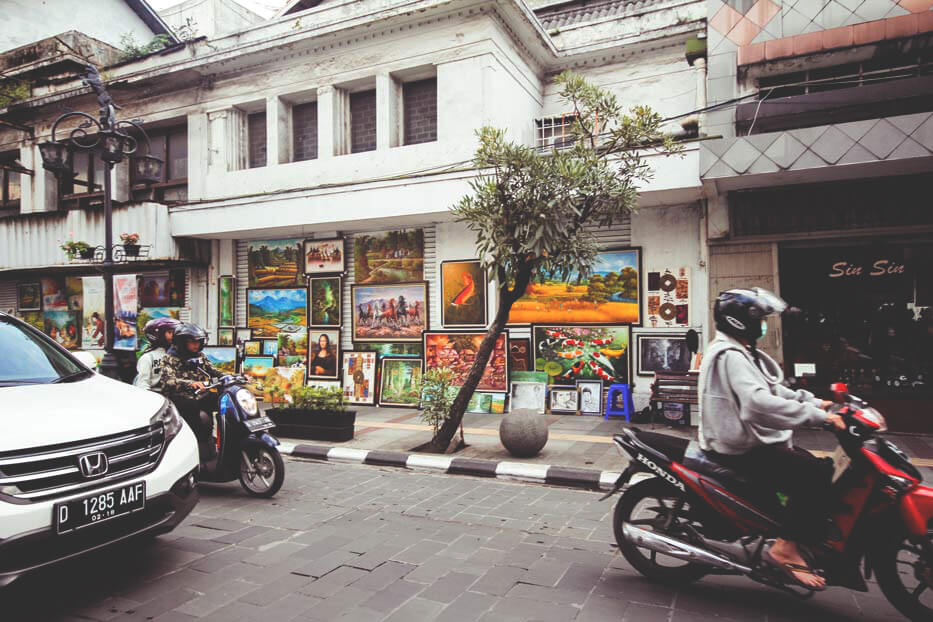
At some point, we arrived at the “Grand Mosque“, a large mosque in the heart of the city. Countless children were playing in the forecourt; it was very busy but somehow cool to watch. We didn’t stay alone for long; a whole crowd of children and teenagers came running towards us with their selfie sticks. They all wanted to take photos with us. We always find this quite funny and usually agree graciously. This time we took a picture ourselves.

We didn’t go back inside the mosque but continued walking through the streets. We didn’t remain undetected for long in the city either. A few girls wanted to speak English with us and asked us a few questions about the language and culture in Indonesia. That’s very typical in Java; you’re always approached by young people. They’re learning English and want to put what they’ve learned into practice. Since the area isn’t particularly touristy, they’re always happy to see Europeans.
Off to Taman Wisata Maribuya Park
The next day, we wanted to explore the area. Not so easy without a scooter or car. We took an Uber taxi to the park entrance of “Taman Wisata Maribuya.” Each of us had to pay about €3.50. Some tried to sell themselves as guides, but we wanted to explore the park on our own.
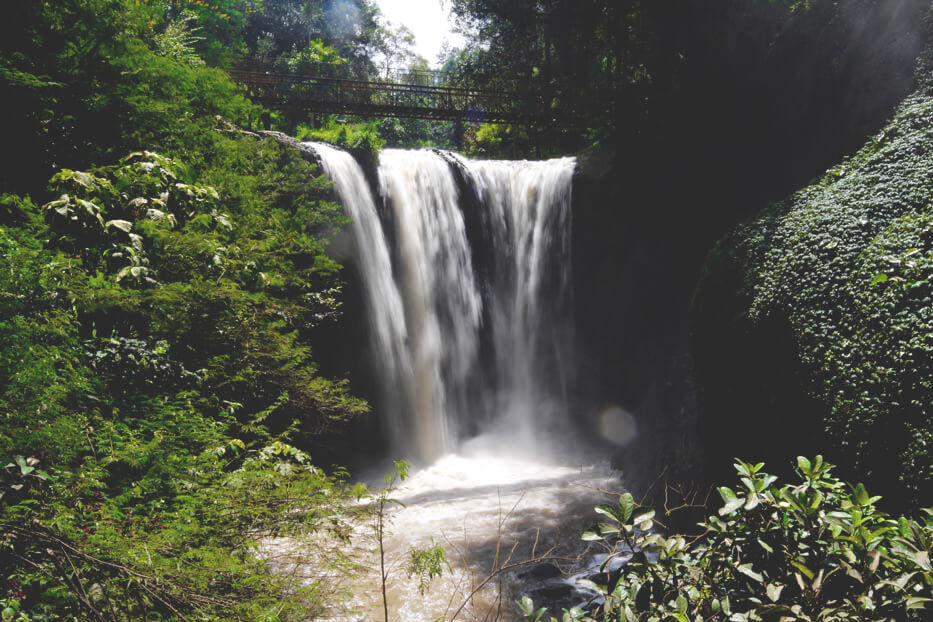
The route to the park exit was just under 5 kilometers. Right at the beginning, we passed a powerful and, above all, loud waterfall. There were two more in the park, but we couldn’t find them or they were dry. In the park itself, you’re often approached and asked if you’d like to ride a scooter. You can always get a chauffeur. We found this completely pointless and decided against it. In the end, it was a pleasant walk with plenty of peace and quiet and no traffic chaos.

The cool Lawangwangi Creative Space
On the last day, I finally wanted to go to the Creative Space. I found this location online and was eager to stop by. We took a taxi and had ourselves dropped off there. The Lawangwangi Creative Space is located north of Bandung (about a 20-minute drive).

This cafe serves delicious drinks, salads, and snacks. The terrace also offers a fantastic view of the natural surroundings, small villages, and settlements. Downstairs, there’s a gallery with constantly changing exhibitions. Adjacent to it is a cool shop with lots of great clothes, shoes, bags, jewelry, and accessories. It was busy that day, probably because of the long weekend.
A train ride to Yogyakarta
Finally, we could move on. One Friday morning, we boarded the train that would take us to Yogyakarta. After all, we had booked “Eksekutif,” so the almost 8 hours weren’t so bad. The journey was truly relaxing, and the seats quite comfortable. We were able to use the time to sleep, watch TV series on the laptop, read, and jot down a few thoughts.
Once again, we traveled through beautiful landscapes with numerous green rice fields. A train journey through Java is truly easy-going and by no means strenuous. We arrived at the train station in Yogya (pronounced something like “Jogja”) and were picked up directly by the son of our Airbnb host. His name was Adit, and he was very polite, kind, and accommodating. We drove to his house and were warmly welcomed by Nin, his mother. Kisses left, kisses right, and then we were right in the middle of it all.
Nin, her husband, two sons, and two maids live there in the beautiful house in the northern center of Yogya. The family has traveled extensively, so they all speak really good English. We had a great time chatting and exchanging ideas. Nin gave us coffee from Sulawesi, delicious cookies, and crackers. We talked about cultures and traditions, laughed a lot, and got along really well right away. It was great to stay with the locals. You get to experience much more of life and culture.
Traveling with a Local
Due to the train ticket chaos, we unfortunately only had two days to do a few things in Yogya. Adit was our guide for that time and told us a lot about himself and his country. He works for a company in England and therefore earns good money for his circumstances (just under $800 a month). The average earns just $200-400 a month. He also works eight hours a day (but usually more), but only has 12 days of vacation a year. He could also take unpaid vacation, but nobody likes that.
People in Asia generally work very hard and much more than we Germans. The school system isn’t all that different from that in Germany. There is a kind of elementary school, a secondary school (Gymnasium/Realschule), and universities. Unlike in Germany, however, in Indonesia you wear a School uniform. Depending on age and grade, you get the uniform in different colors. However, the costs are not cheap. Education isn’t “free” like it is in Germany. Here, you have to pay a lot (many can’t even afford it). Adit’s brother, for example, has to pay almost $40,000 for his studies. And that’s quite a considerable sum for Indonesians.
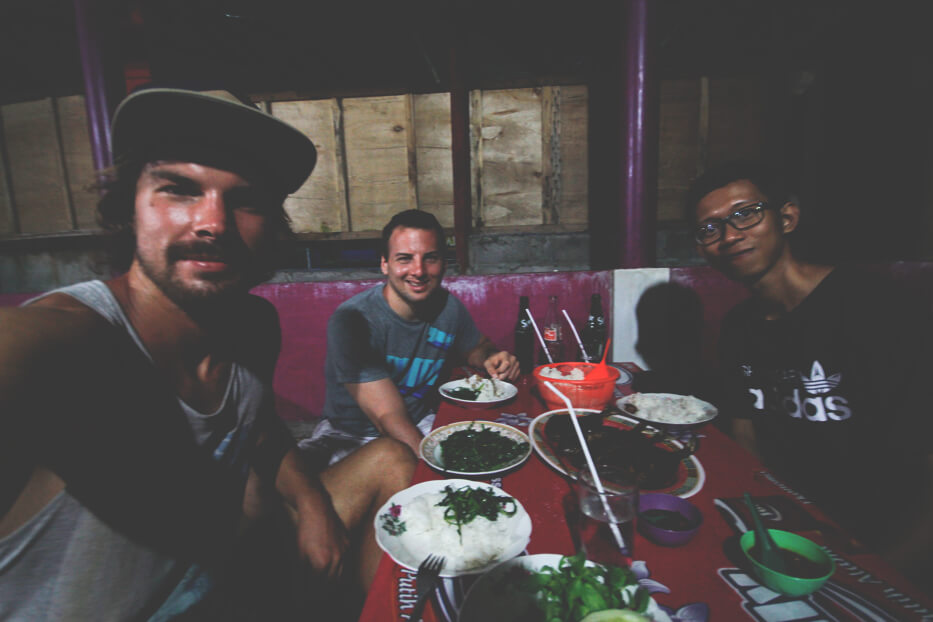
Nin also told us that the culture in Bali, for example, is completely different from that in Java. In Bali, it’s normal for a man to have several wives. That’s not the case in Java. We learned many interesting things from Nin and her family. Different languages are also spoken in Indonesia.
For example, a Balinese person usually doesn’t understand when someone from Java speaks. Indonesians, just like Thais, eat a lot of rice and enjoy it. They have rice in the morning, at lunch, and for dinner. But Nin made sure we also had toast, jam, eggs, and fruit every day – simply fantastic!
Yogyakarta is a true student city; many universities are located here in the educational center of the island of Java. Almost 100,000 students are said to live and study here. Yogya is particularly popular due to its many beautiful temples, such as Borobodur and the famous Prambanan Temple. There are also several beaches in the south. No wonder, then, why most people, especially locals, go to Yogya.
The unique Borobodur Temple
Together with Adit, we drove almost two hours to the Borobodur Temple. It was very hot that day, and because it was a long weekend, the entire complex was quite crowded. We had to go to the “Foreigner Counter” to buy our ticket.
As always, locals only pay a fraction of what we tourists have to pay. The entrance fee was a hefty $20. On the one hand, it’s understandable, but on the other hand, the prices are truly outrageous. But that’s another topic. So we wandered through the park, wrapped in warm blankets.
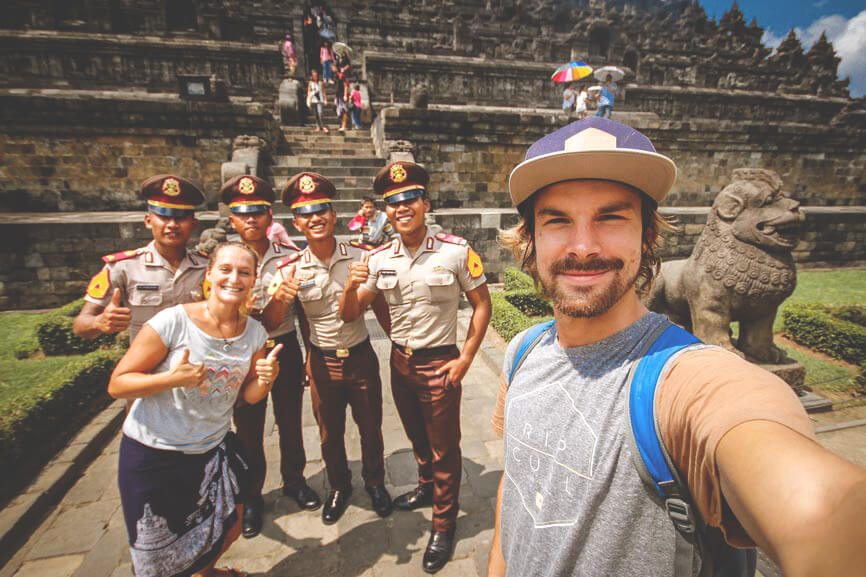
The Borobodur Temple is the largest Buddhist temple complex in Indonesia. In 1991, the colossal pyramid was declared a UNESCO World Heritage Site. It is also considered the most important Mahayana Buddhist building on Java. We strolled through the various corridors, repeatedly trying to find shade.
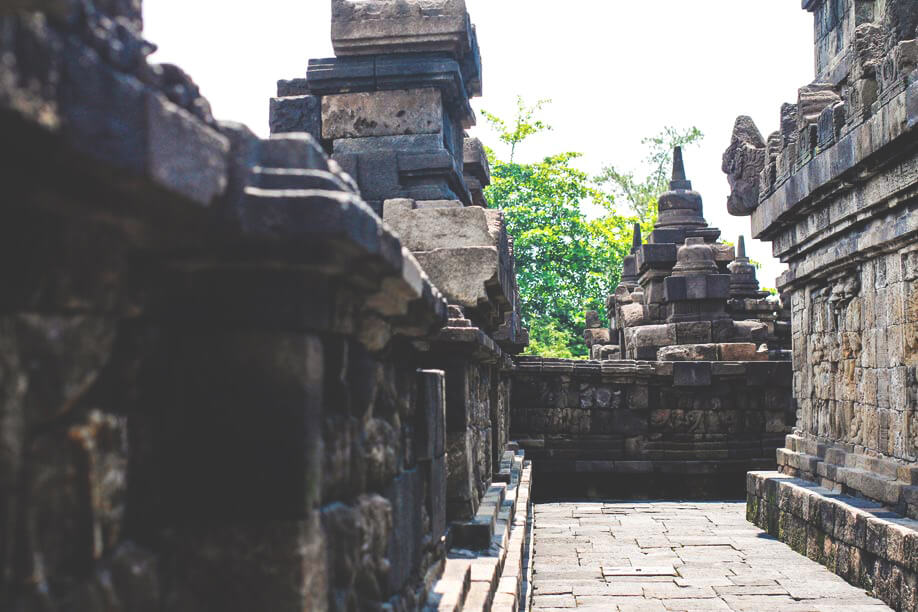
It was so unbearably hot that day that not a single centimeter of my clothing remained dry. At the end, we met four young police officers (presumably in training). We actually wanted to ask them if we could take a picture together, but they got there first. Somehow they reminded me of the Police Academy :D!

The impressive Prambaran Temple
The next day, we drove in the other direction to the Prambanan Temple. This time, the traffic was quieter, and it only took us about 25 minutes. We had to pay a hefty $18 at the entrance. We paid again, but we found this price completely unreasonable. The locals pay a mere 3-4 euros. Well, the tour of the complex was finally about to begin. It was hot again, but you could find a shady spot here and there.
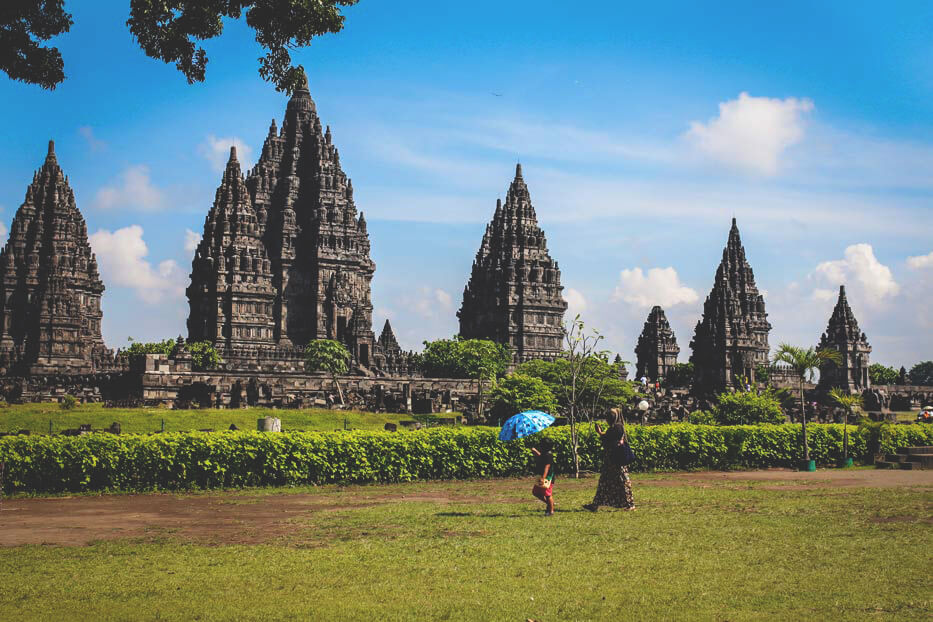
We strolled through the beautiful park. It was much quieter than at Borobodur. Most of the vacationers and visitors were probably already on their way home. From a distance, we could see the complex. It looked simply amazing—somehow so mysterious and at the same time somehow eerie. I felt like I was in a Tomb Raider game. At some point, I would see Lara Croft jumping from tower to tower, fighting some tigers. Unfortunately, she wasn’t there that day.
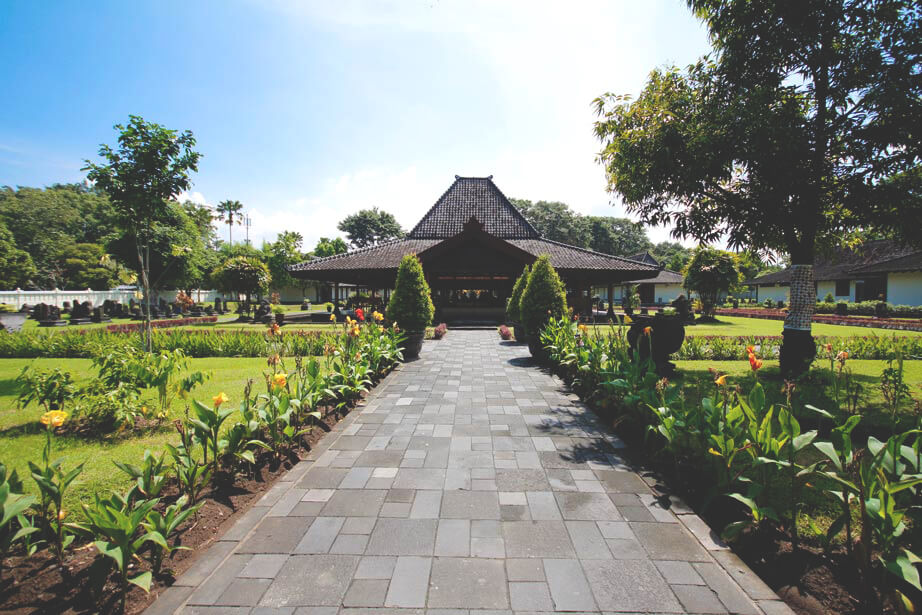
And like almost every day on Java, we were bombarded with questions that day too. Everyone wanted to ask their questions, but sometimes we had the impression that they were simply memorized and rehearsed. Often, they didn’t react to our answers at all and simply moved on to the next question. After the first five or six “interviews,” we politely and politely blocked them. It was slowly becoming too much for us. Now we wanted to explore the complex in peace.
The Prambanan Temple is the largest Hindu temple complex in Indonesia and was built around 850 AD. This temple was also recognized as a UNESCO World Heritage Site in 1991. This complex is particularly beautiful because you have “more room to breathe.” It’s not so cramped, and you can explore each individual temple. They all have a pointed design, typical of Hindu temples.
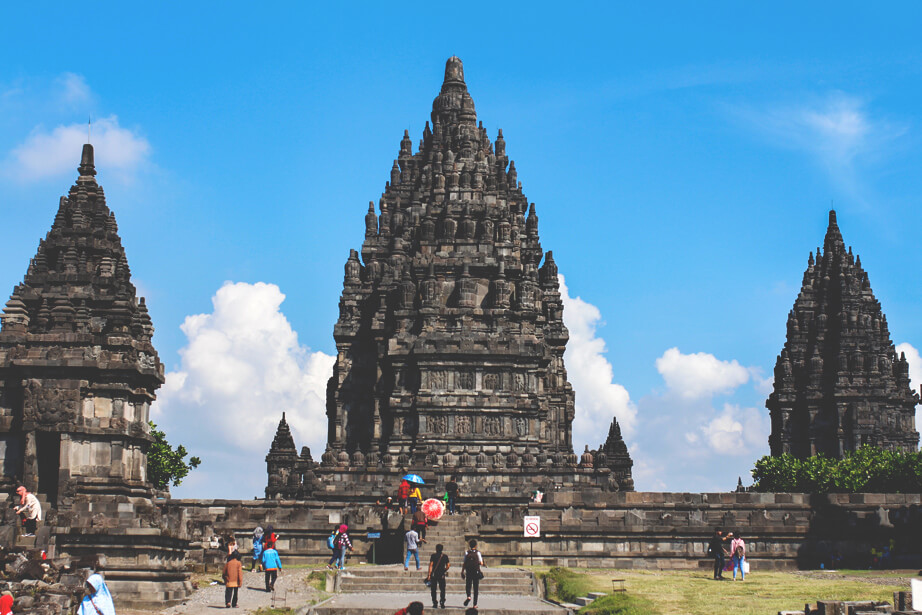
The main building in the middle is almost 47 meters high. We found this complex much more beautiful than the Borobodur Temple. Everything here was somehow more relaxed. We also really liked the architecture. In the park itself, there are a few other temples and a museum. At the exit, you’ll find one stall after another selling food, drinks, souvenirs, and lots of useless stuff. Just close your eyes and get through it!
Since I had to go back to work, the boys drove south to the beach again. It was quite relaxing and pleasant, but again there was far too much trash lying around. This trash probably washed up. Unfortunately, we saw that often, and the trash problem is certainly not insignificant throughout Indonesia. But for a short trip to the sea, it’s a welcome change.

So this is where our tour of Java ended. We would have liked to see much more and would have liked to have continued east. Unfortunately, we didn’t have enough time. Maybe we’ll visit the other side of the island again (Surabaya, Karimunjava, Mount Bromo, etc.).
We especially liked the Thousand Islands and the Prambanan Temple in Yogyakarta. The train rides were really relaxing and pleasant. We had two great weeks on Java and met a lot of cool people. At this point, best wishes to Marc from England, Vikan from Jakarta, Nina from Germany, as well as Nin and the whole family from Yogyakarta.
Our accommodations at a glance
- Jakarta: Packers Lodge
- Jakarta: Teduh Hostel
- Thousand Islands: Airbnb accommodation (here)
- Bandung: Pinisi Backpacker Hostel (terrible!)
- Bandung: Garden Hostel
- Yoygakarte: Airbnb accommodation (here)
With our invitation link, you currently get a €30 discount on your first booking. We usually book our accommodations through Booking.com*, as the selection is simply huge. But Expedia and Agoda can also compete quite well.
Train tickets Java
You can buy these at any train station. Make sure you don’t buy the ticket on the day of departure. It can happen that tickets are sold out or only the most expensive category is available. Trains usually have three classes (economy, business, and executive).
Costs vary depending on the route and destination. Our cheapest ticket was 6 euros (Jakarta to Bandung) and our most expensive was just under 25 euros (Bandung to Yogyakarta). In general, traveling by train is really inexpensive. It’s also relaxing, and you can enjoy the great views. You can find more information about train tickets in Java here on the train travel blog.